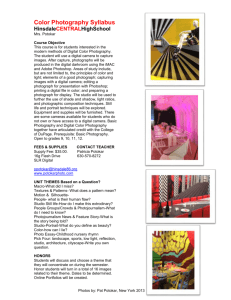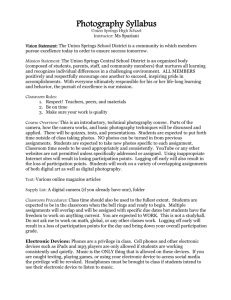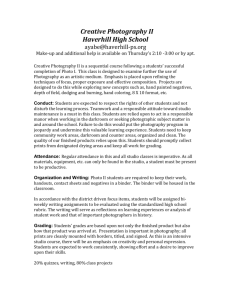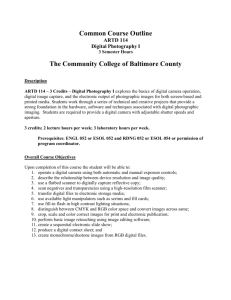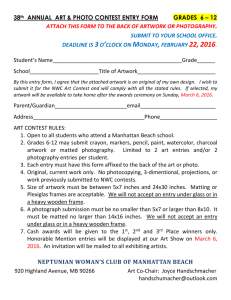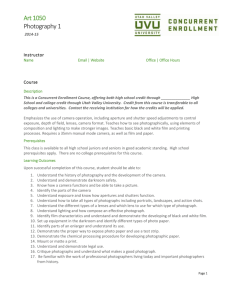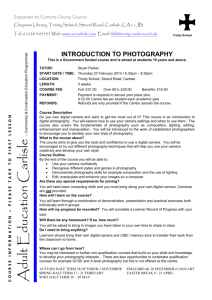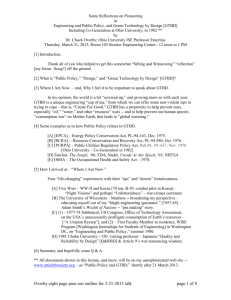Photo 1 Syllabus - East HS Digital Photo
advertisement
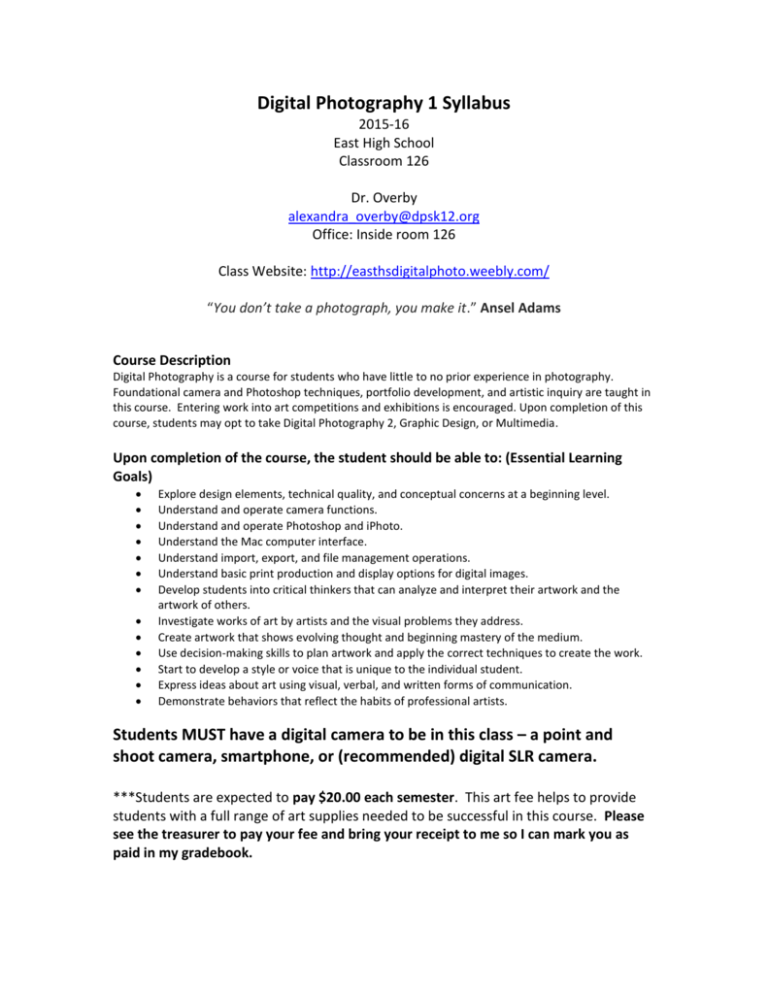
Digital Photography 1 Syllabus 2015-16 East High School Classroom 126 Dr. Overby alexandra_overby@dpsk12.org Office: Inside room 126 Class Website: http://easthsdigitalphoto.weebly.com/ “You don’t take a photograph, you make it.” Ansel Adams Course Description Digital Photography is a course for students who have little to no prior experience in photography. Foundational camera and Photoshop techniques, portfolio development, and artistic inquiry are taught in this course. Entering work into art competitions and exhibitions is encouraged. Upon completion of this course, students may opt to take Digital Photography 2, Graphic Design, or Multimedia. Upon completion of the course, the student should be able to: (Essential Learning Goals) Explore design elements, technical quality, and conceptual concerns at a beginning level. Understand and operate camera functions. Understand and operate Photoshop and iPhoto. Understand the Mac computer interface. Understand import, export, and file management operations. Understand basic print production and display options for digital images. Develop students into critical thinkers that can analyze and interpret their artwork and the artwork of others. Investigate works of art by artists and the visual problems they address. Create artwork that shows evolving thought and beginning mastery of the medium. Use decision-making skills to plan artwork and apply the correct techniques to create the work. Start to develop a style or voice that is unique to the individual student. Express ideas about art using visual, verbal, and written forms of communication. Demonstrate behaviors that reflect the habits of professional artists. Students MUST have a digital camera to be in this class – a point and shoot camera, smartphone, or (recommended) digital SLR camera. ***Students are expected to pay $20.00 each semester. This art fee helps to provide students with a full range of art supplies needed to be successful in this course. Please see the treasurer to pay your fee and bring your receipt to me so I can mark you as paid in my gradebook. Colorado Standards for Visual Art 1. Observe and Learn to Comprehend 1. Visual art has inherent characteristics and expressive features 2. Historical and cultural context are found in visual art 3. Art and design have purpose and function 2. Envision and Critique to Reflect 1. Reflective strategies are used to understand the creative process 2. A personal philosophy of art is accomplished through use of sophisticated language and studio art processes 3. Interpretation is a means for understanding and evaluating works of art 3. Invent and Discover to Create 1. Demonstrate competency in traditional and new art media, and apply appropriate and available technology for the expression of ideas 2. Assess and produce art with various materials and methods 3. Make judgments from visual messages 4. Relate and Connect to Transfer 1. The work of art scholars impacts how art is viewed today 2. Communication through advanced visual methods is a necessary skill in everyday life 3. Art is a lifelong endeavor Studio Habits of the Mind Develop Craft Engage & Persist Envision Express Observe Reflect Stretch & Explore Understand Art World Learning to use and care for tools (e.g., viewfinders, brushes), materials (e.g., charcoal, paint). Learning artistic conventions (e.g., perspective, color mixing). Learning to embrace problems of relevance within the art world and/or of personal importance, to develop focus and other mental states conducive to working and persevering at art tasks. Learning to picture mentally what cannot be directly observed and imagine possible next steps in making a piece. Learning to create works that convey an idea, a feeling, or a personal meaning. Learning to attend to visual contexts more closely than ordinary "looking" requires, and thereby to see things that otherwise might not be seen. Question & Explain: Learning to think and talk with others about an aspect of one’s work or working process. Evaluate: Learning to judge one’s own work and working process and the work of others in relation to standards of the field. Learning to reach beyond one's capacities, to explore playfully without a preconceived plan, and to embrace the opportunity to learn from mistakes and accidents. Domain: Learning about art history and current practice. Communities: Learning to interact as an artist with other artists (i.e., in classrooms, in local arts organizations, and across the art field) and within the broader society. Career & Technical Education Standards VA09-GR.HS-S.1-GLE.3-EO.c - Interpret the purposes of art across time, culture, and diversity, and be mindful of cultural sensitivities VA09-GR.HS-S.3-GLE.1-EO.a - Articulate ideas that can be expressed in traditional, advanced, and evolving media VA09-GR.HS-S.3-GLE.1-EO.b - Investigate and document a wide range of traditional, advanced, and evolving media used in creating images that communicate ideas VA09-GR.HS-S.4-GLE.2-EO.a - Use sketches, plans, and models to create and/or design a functioning work of art VA09-GR.HS-S.4-GLE.3-EO.b - Research the range of careers available to artists such as museum curation, automobile design, gaming design, medical illustration, and photojournalism VA09-GR.HS-S.4-GLE.3-EO.c - Outline required training for one’s individual career goals Expectations Be Prepared for Class Students must come to class on time and ready with their materials and assignments. Be Respectful of Others and the Studio Space A courteous studio environment maximizes the opportunity for learning. Work Everyday There is always something that can be accomplished in the studio – let’s make the most of our learning time. Assessments You will be graded on: Demonstrating artistic practice and maturity in work habits Discussions, reflections, and tutorials/assignments to learn the concept/skill Creation of artwork Critique and reflection about artwork Development of a personal website about your artwork You may redo projects for a higher grade. Assignments will be penalized if turned in late due to unexcused absences, not working in class, etc. Projects (includes participation and attendance in class) 60% Classwork (tutorial completion, discussions, small assignments) 30% Final Project/Exam 10% Personal Website and Dropbox: In this class, you will be creating a website through Weebly to present your artwork and demonstrate understanding of key concepts. This website is for your classwork only, however, you may add items of an academic nature (awards, exemplar essays, etc.) so that colleges may look at your work as part of your application process. Students will also be required to have a Dropbox account to turn in work. Both Weebly and Dropbox are no cost to the student. Attendance and Tardies: Due to the hands-on nature of this course, it is crucial you attend all classes. Being late causes disruptions to the working environment of the class for the whole class, so it is important you are on time. There will be some homework involved in this course. Students are welcome to pre-arrange time to come and work in the studio to catch up on missing work or extend their learning. Cell Phones and Food: Cell phones are only to be used during approved times and only for taking and sharing photos. No food in the studio. Water bottles that can seal are ok to bring in. Camera and Equipment Checkout: East HS has a limited number of digital SLR cameras and equipment for student use. Students may check out cameras/equipment during class time or after school. It must be returned at the end of class, or if checked out after school, the very next morning. Failure to return equipment will result in a loss of participation points. Repeated abuse of the checkout system will revoke the student’s privilege to check out equipment. Artistic Integrity: Plagiarism is unethical and will not be tolerated. Copying someone else’s work or taking someone else’s work and calling it your own will be cause for disciplinary action, including failing the assignment. When using reference material such as photographs, drawings, or designs, students must apply their own personal vision to sustainably alter the original work (move beyond duplication). Things to Remember… YOU are responsible for your computer station and any equipment you check out. Be respectful to all who use the studio or you may lose privileges to the space and supplies. Work assigned in class is just the start to becoming a stronger artist. Feel free to create more work or refine past assignments. Be open to visiting art events around the metro area. Looking and learning about art outside of class time will help you become a stronger artist. Be receptive to criticism of your work. Participating in critique and reflecting on feedback is the best tool for growing as an artist. You do not have to agree with every critique of your work, but be open to hearing how others see and understand your art. Develop habits of a lifelong learner. Continue to seek new knowledge and experiences. Remember that even experts do not have all the answers. Parent/Guardian Role: Parents and Guardian support is part of the answer to student success. Please ask to see your student’s artwork via their webpage on a regular basis and have them discuss what they are learning. If you need to contact me, please email me. Parents and Guardians are always welcome in the studio. Donations and Volunteers: The East HS Photography program is growing! We welcome any donations of funds or camera/camera equipment to make our program even better. Volunteers are always welcome to help with field trips and all our art events. Outline of Concepts – Semester 1 Introduction to the Studio Environment Using Photoshop, Bridge, and Dropbox Elements of a Good Photograph/Composition Theory Behind Selfies/Self Portraits Parts of the Camera/How a Camera Works History of Photography (beginnings to the Brownie Camera) Landscape Photography HDR process Re-photography Family Photography Conceptual Photography (creating work on an idea) Double/Multiple Exposure Designing and Maintaining a Web Page Portfolio Development Please detach and return to Dr. Overby by August 28, 2015. EHS Digital Photography 1 Contract ***By signing below, I agree to adhere to all rules and regulations imposed by the Digital Photography 1 course as well as the East High School and Denver Public Schools guidelines. Materials Fee for this course is $20.00 per semester. I understand I need to have a digital camera (point and shoot, SLR, or smart phone) for this course. I understand that I will be creating a personal website that will focus on my artwork and assignments for this class only. Student Name: _______________________________________ Period: ______ Signature:_______________________________________Date:_____________ Parent/Guardian Name:______________________________________ Signature: _______________________________________Date:_____________ Please contact Dr. Overby at alexandra_overby@dpsk12.org if you have any questions or concerns.


